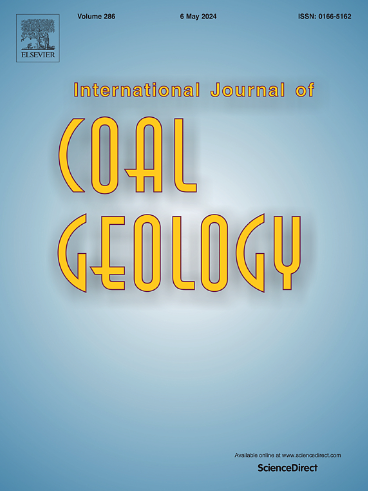Hydrocarbon generation potential and organic carbon enrichment in evaporitic lacustrine source rocks from the Qianjiang Formation, Jianghan Basin (Central China): An integrated geochemical-petrological investigation
IF 5.7
2区 工程技术
Q2 ENERGY & FUELS
引用次数: 0
Abstract
Continental hypersaline lacustrine basins constitute critical repositories of unconventional shale oil resources, often hosting source rocks with primary exploration value. The hydrocarbon generation potential and organic matter accumulation within the Qianjiang Formation of Jianghan Basin, however, remain elucidated inadequately. This study targets the third member of the Qianjiang Formation (Eq3) through systematic analysis of dolomitic shale sequences from the QYP1 directional well in Qianjiang Depression. A comprehensive analytical approach is employed, integrating programmed open-system pyrolysis, major and trace element geochemistry, biomarker analysis, and organic petrology. The multidisciplinary framework is utilized to evaluate sediment provenance, organic matter supply, paleoenvironmental reconstruction (including paleoclimate, redox condition, and paleosalinity) during the Eq3 depositional period, and the thermal maturity of organic matter. Based on these influencing factors, the hydrocarbon generation potential and organic matter enrichment model for source rocks of the Eq3 interval are assessed.
Results demonstrate that the organic-rich sediments of the Eq3 shales in the Qianjiang Depression exhibit exceptional hydrocarbon potential, qualifying as prime targets for shale oil exploration. Key characteristics include elevated total organic carbon (TOC), elevated S1 + S2 values, and superior hydrogen index (HI). Primary source of organic matter is attributed to saline lacustrine algae, as evidenced by a strong linear correlation between liptinite and TOC content and high proportion of lamalginite. The analyzed organic matter exhibits thermal maturity levels ranging from immature to low-mature level. Organic matter enrichment in these evaporative lacustrine source rocks is controlled by a combination of factors, including paleoclimate, sediment supply, organic matter sources, and depositional conditions. Paleoclimate reconstructions indicate that the Eq3 interval was deposited under cold and arid conditions, with low Ga/Rb, SiO2 and high K2O/Al2O3, Al2O3 + K2O + Na2O, accompanied by weak chemical weathering with minimal sediment recycling. Depositional environment demonstrates strongly reducing conditions and exceptional organic matter preservation, as indicated by low Pr/Ph ratios, exceptionally high Gamm/C30 (βα + αβ) hopane indices, rominent extended tricyclic terpanes ratios (ETR) and widespread pyrite occurrence. Elevated gammacerane, β-carotane content, along with high Sr/Ba, B/Ga and DBT/P radios, suggest high paleosalinity. Water column stratification further enhanced paleoproductivity and provided optimal conditions for organic matter preservation. Hydrocarbon-generating organic matter is predominantly derived from aquatic algae and halotolerant bacteria, with negligible contributions from terrestrial higher plants. Laminated algal mats dominate the organic composition, indicating extensive preservation of algae. This study is designed to elucidate the mechanisms governing organic matter enrichment in evaporative lacustrine basins and provides a robust foundation for shale oil exploration in the Qianjiang Depression.
江汉盆地潜江组蒸发湖相烃源岩生烃潜力与有机碳富集:地球化学-岩石学综合研究
陆相高盐湖相盆地是非常规页岩油的重要储层,往往蕴藏着具有重要勘探价值的烃源岩。然而,对江汉盆地潜江组的生烃潜力和有机质聚集的认识仍不充分。通过对潜江凹陷QYP1定向井的白云质页岩层序进行系统分析,研究了潜江凹陷钱江组三段(Eq3)。采用了一种综合分析方法,将程序开放系统热解、主要和微量元素地球化学、生物标志物分析和有机岩石学相结合。利用多学科框架对东三期沉积物源、有机质供应、古环境重建(包括古气候、氧化还原条件和古盐度)和有机质热成熟度进行评价。在此基础上,对东三段烃源岩的生烃潜力和有机质富集模式进行了评价。结果表明,钱江坳陷东三组页岩富有机质沉积物具有良好的油气潜力,是页岩油勘探的主要目标。主要特征包括总有机碳(TOC)升高,S1 + S2值升高,氢指数(HI)优越。有机质主要来源为咸化湖相藻类,脂质岩与TOC含量呈较强的线性相关关系,且板藻质岩比例较高。所分析的有机质表现出从未成熟到低成熟的热成熟度水平。这些蒸发湖相烃源岩的有机质富集受古气候、沉积物供应、有机质来源和沉积条件等综合因素的控制。古气候重建表明,鄂西3段沉积条件寒冷干旱,Ga/Rb、SiO2较低,K2O/Al2O3 (Al2O3 + K2O + Na2O)较高,化学风化作用弱,沉积物再循环最小。沉积环境具有较低的Pr/Ph值,较高的γ /C30 (βα + αβ)藿烷指数,较高的扩展三环萜烷比(ETR),黄铁矿分布广泛,显示出较强的还原条件和良好的有机质保存。伽马蜡烷、β-胡萝卜烷含量升高,Sr/Ba、B/Ga和DBT/P比值较高,表明古盐度较高。水柱分层进一步提高了古生产力,为有机质保存提供了最佳条件。生烃有机质主要来自水生藻类和耐盐细菌,陆生高等植物的贡献微不足道。层状藻席在有机成分中占主导地位,表明藻类被广泛保存。本研究旨在阐明蒸发湖盆有机质富集机理,为潜江坳陷页岩油勘探奠定基础。
本文章由计算机程序翻译,如有差异,请以英文原文为准。
求助全文
约1分钟内获得全文
求助全文
来源期刊

International Journal of Coal Geology
工程技术-地球科学综合
CiteScore
11.00
自引率
14.30%
发文量
145
审稿时长
38 days
期刊介绍:
The International Journal of Coal Geology deals with fundamental and applied aspects of the geology and petrology of coal, oil/gas source rocks and shale gas resources. The journal aims to advance the exploration, exploitation and utilization of these resources, and to stimulate environmental awareness as well as advancement of engineering for effective resource management.
 求助内容:
求助内容: 应助结果提醒方式:
应助结果提醒方式:


